From ‘Domestic Science’ to innovative research: College of Health and Human Sciences
A CSU @ 150 Story by Gretchen Gerding published April 6, 2020Women have always studied at Colorado’s land-grant institution even before there were any specific courses for them – President Charles Ingersoll instituted the liberal-arts focused “Ladies Course” in 1882. But it took a woman’s fortitude and advocacy to launch the new program in Domestic Economy at Colorado Agricultural College in 1895.
Eliza Pickrell Routt was the first in a long history of female leaders who promoted women’s capabilities, and who made notable contributions to the development of what later became the College of Home Economics, today the College of Health and Human Sciences at Colorado State University. These leaders also held science and research in high regard and integrated it into CAC’s educational program for women from the start.
From suffragist to education leader
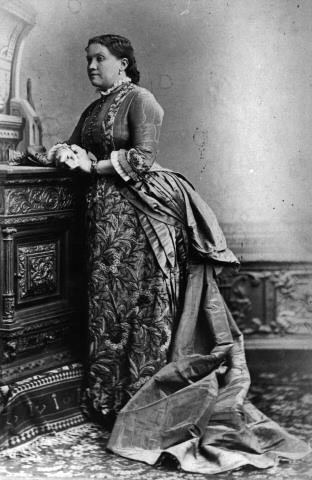
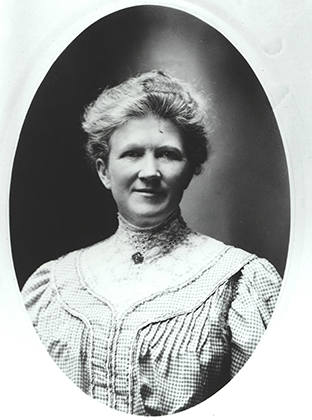
Eliza Pickrell Routt (left) and Theodosia G. Ammons were the first among the many female leaders who played key roles in the college’s history.
Before her appointment as the first woman to serve on the State Board of Agriculture, the governing body of Colorado’s land-grant institution, Routt was an avid supporter of women’s right to vote. She was elected president of the Denver Equal Suffrage League, who helped win passage of the 1893 referendum giving Colorado women the right to vote.
Joining the State Board in 1895, Routt immediately began to organize the program in Domestic Economy, which had been approved by the Board the year before. A large majority of women in those days were homemakers, and the program met a need for formal training in how to maintain household health, nutrition, and the family budget. Routt hired Theodosia G. Ammons, who had worked closely with her in the suffrage movement, to oversee the new program. Ammons believed in incorporating a sound scientific background into the curriculum, including education in germ theory as part of the nursing course.
The early curriculum “included classes in the chemistry of cooking, home hygiene, household economics, nursing, sewing, [and] kitchen management,” CSU historian James Hansen writes in Democracy’s College in the Centennial State: A History of Colorado State University.
Read more stories about the College of Health and Human Sciences in this series celebrating the 150-year history of Colorado State University.
Video: Award-winning Legacies Project records personal and professional histories
Grace Espy Patton: ‘Better still to be a Colorado woman’
Nancy Richardson Design Center was a busy hub of collaboration, innovation in first year

Advocating for women
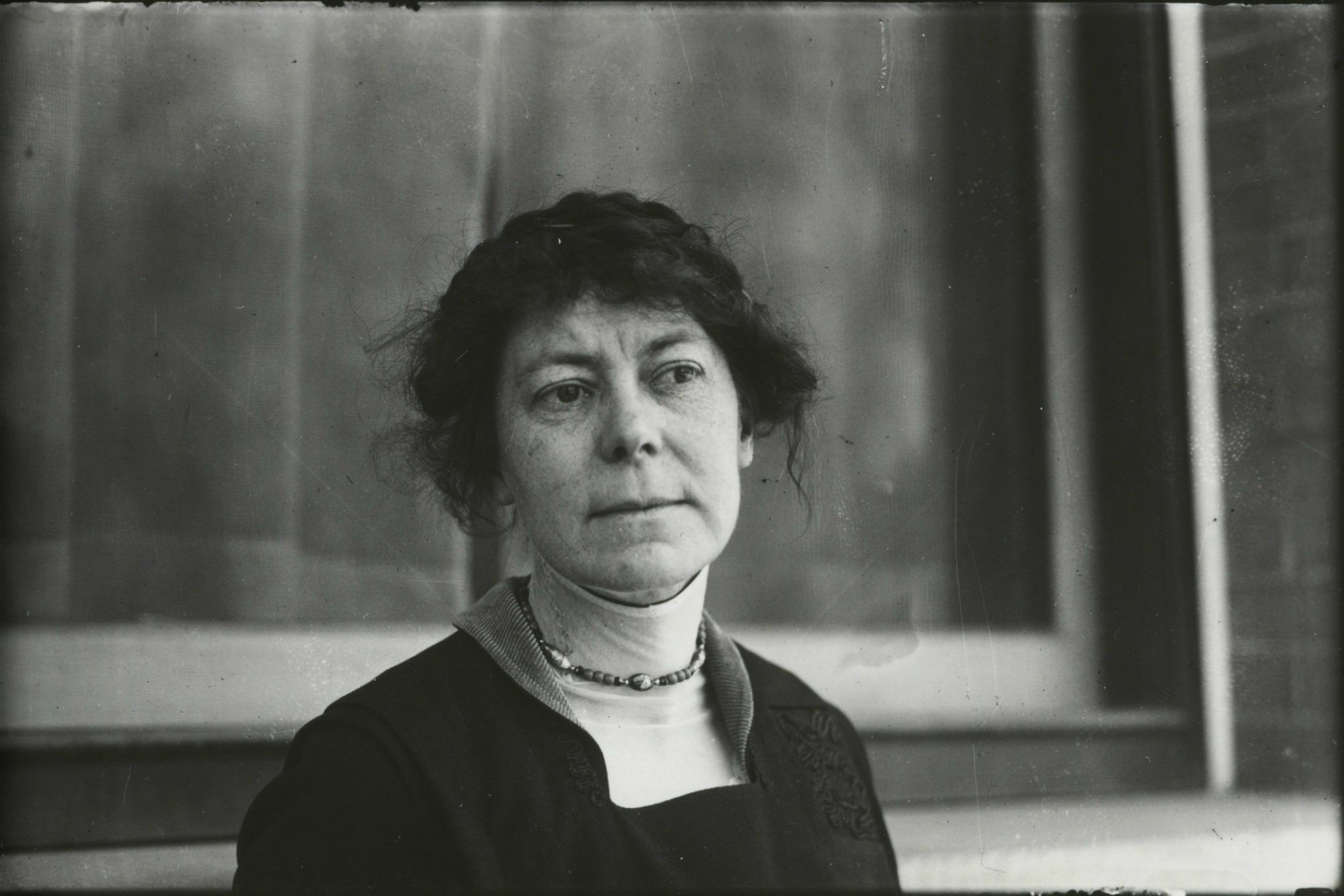
Inga Allison became acting department chair in 1910.
As an advocate for equality, Routt secured compensation and rank for Ammons that was comparable to other male department heads. Routt’s ambition for the program included securing funds for construction of a new building. Although she and Ammons both passed away in 1907, that effort came to fruition in 1910 when the Simon Guggenheim Hall of Household Arts opened. The contributions of both Routt and Ammons are commemorated on the stained glass window in the Guggenheim Building on campus, which now houses the College’s Department of Construction Management. Routt is also the namesake of Routt Hall on campus (although Ammons Hall is named for Theodosia’s brother, Elias, Colorado’s 19th governor).
Mary F. Rausch became head of home economics in 1907, continuing the outreach work she had done in Iowa, including bringing short courses to rural areas outside of Fort Collins and lecturing to groups on the science of home economics. Rausch became ill, however, leading to the appointment of Inga Allison as acting department chair in 1910.
Research on high-altitude baking
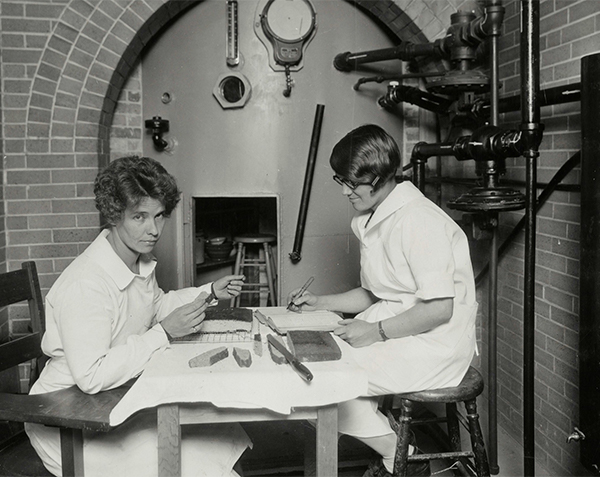
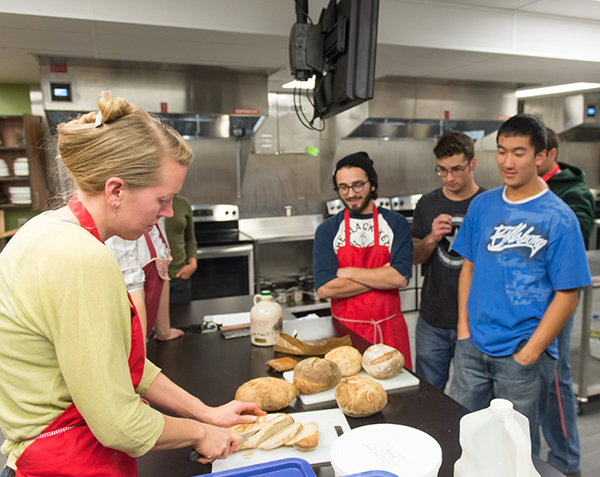
Then and now: The study of high-altitude baking has been a staple at CSU since the high-altitude baking laboratory was completed in Guggenheim in 1927.
Allison had come to Colorado Agricultural College after earning her science degree at the University of Chicago. Allison’s talent for research led her to conduct early experiments on the effects of high altitude on baking, including up in Estes Park at a shanty on Fall River Road. She also enlisted the help of physics instructor Charles Lory, using equipment to test the cooking times of foods in water at various atmospheric pressure. A first-of its kind high-altitude baking laboratory was completed in Guggenheim in 1927, with a pressure chamber that could simulate different altitudes to test recipes and make adjustments in baked goods so that they would rise successfully.
Quite a bit of painstaking research and testing was conducted to help solve the challenges of high-altitude baking, which involved a combination of chemistry and physics. A bulletin from 1930, “Baking Quick Breads and Cakes at High Altitudes, a Guide to Housewives,” included instructions for ingredients and temperatures for successful baking at elevations ranging from 3,000 to 11,180 feet above sea level and involved experimenting with about 1,300 cakes.
Sound leadership
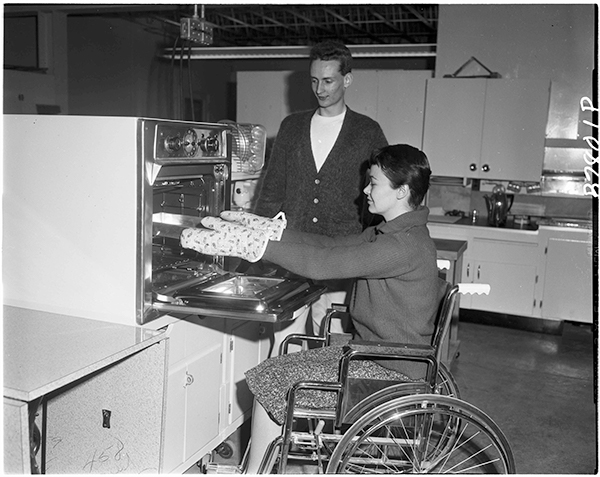

Then and now: Occupational Therapy was established in 1945. Today the nationally ranked program is training future leaders to help people who face challenges with everyday life.
Allison’s influence on the Department of Home Economics was long and wide-ranging, as she led the unit through the post-war period of the 1940s. Under her leadership, home economics grew, offering multiple areas of study, including the traditional food science and nutrition and textiles and clothing, and adding child development with the addition of a preschool program in 1929. The laboratory school still exists today – the Early Childhood Center, in the historic Washington School, is a part of the Department of Human Development and Family Studies, and recently celebrated its 90th anniversary.
In 1919, the program added a “practice house” for students to learn the various practical aspects of home management by living in and running the house for a number of weeks. Under Allison’s leadership, the home economics course of study also provided preparation for careers as dietitians, Extension workers, laboratory and research workers, and teachers. By the 1930s, actual majors were offered, including teaching in conjunction with the Department of Rural and Vocational Education.
One major development under Allison was the addition of Occupational Therapy in 1945. The program has now grown into the nationally ranked Department of Occupational Therapy. Initially a bachelor’s degree, the field changed to a master’s only, and continues to evolve as the program plans to move to offering a three-year doctoral program in OT, which will join the research Ph.D. that the department offers.
College of Home Economics experiences dynamic growth

The next period of growth in the College occurred under the leadership of Elizabeth Dyer Gifford, who became the dean of the School of Home Economics in 1950 and served until 1975. After earning her Ph.D. in food science and nutrition at the University of Missouri, Gifford joined CSU in 1940 as a nutrition scientist and educator. In honor of her 35 years of service, the Home Economics building on campus was named the Elizabeth Dyer Gifford Building in 1976.
The commemorative materials were dedicated to Gifford and her remarkable achievements, stating, “From the seed of the ‘ladies course’ planted over 80 years ago, has grown one of the nation’s largest and most comprehensive colleges of home economics, dedicated to helping individuals and families meet their needs at home and in the community … During her tenure as dean, the School of Home Economics became a college with five departments offering 21 areas of specialized study within eight majors, the student body quadrupled in size and the number of faculty increased from 16 to 77.”
In a college newsletter article from 1975 in honor of Gifford’s retirement, the following was attributed to her: “Home economics at CSU started in the 1890s with a strong emphasis even then on science – chemistry of cooking, math, physics, the science of nutrition in addition to home hygiene, millinery, [and] social duties and has progressed to a complex integration of the biological, chemical, physical, psychological, and social sciences and their application to an improved quality of living.”
Home Economics only one half of college story
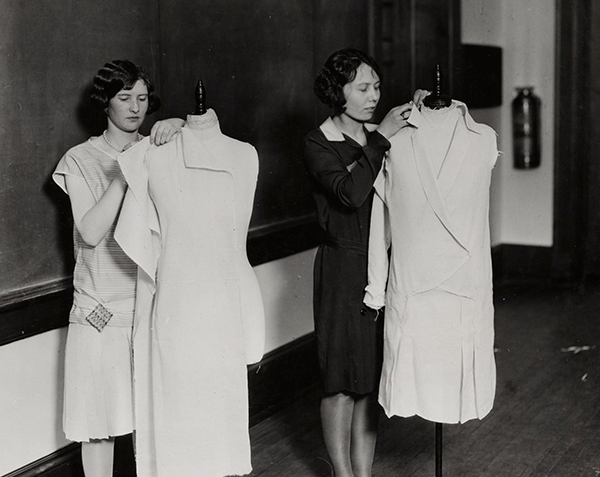

Then and now: Design and Merchandising has its roots in the College of Home Economics.
Under the leadership of the next dean, Helen McHugh, the College of Home Economics became the College of Human Resource Sciences. In 1986, the College of Professional Studies, which was formed in 1975, merged with Human Resource Sciences to form the College of Applied Human Sciences. Today’s departments of Design and Merchandising, Food Science and Human Nutrition, Human Development and Family Studies, and Occupational Therapy all have their roots in Home Economics. The discipline of Home Economics was renamed Family and Consumer Sciences, now an interdisciplinary major in the School of Education that prepares educators to teach a variety of courses in family development, teen relationships, interior and apparel design, and nutrition.
Today’s departments of Construction Management and Health and Exercise Science, and schools of Education and Social Work, all were programs in various forms in the College of Professional Studies.
Construction Management at Colorado A&M began in 1945 as the University’s first interdepartmental degree program in Light Construction and Marketing, with a focus on engineering, math, and business. A wealth of information about the evolution of the department is available in a history publication compiled in 2006 for its 60th anniversary.
Health and Exercise Science can be traced back to CAC’s early emphasis on athletics and exercise, with classes held in Old Main until the South College Gym (today the Glenn Morris Field House) opened in 1926. Ammons Hall, now the home of CSU Admissions, housed the women’s physical education program. In 1938, physical education was established as an undergraduate major. By the mid-1960s with the addition of Moby Gymnasium, men’s and women’s P.E. programs had been combined into one unit, and athletics had become a separate department.
The primary mission of the department was to train students for roles as P.E. teachers and coaches. But increasingly, the role of exercise in human health and well-being became a focus. Today, the department focuses exclusively on preparing students for careers in the health professions and wellness industry and conducting innovative research focused on human health. The Human Performance Clinical Research Lab is designated by CSU as a Program of Research and Scholarly Excellence.
Beginning as a program in Department of Sociology, the bachelor’s degree in social work was accredited in 1974, one of the first in the United States; an MSW was approved in 1984. A major milestone for the program happened in 2002 when it officially became the School of Social Work, which reflected the advanced degree and level of research activity happening in the School. And, in 2011, a Ph.D. was added. Learn more about the history of the School of Social Work on CSU’s SOURCE.
Today’s School of Education was formed when two departments were merged in 1986 – Education and Vocational Education merged into the School of Occupational and Educational Studies. The teacher and principal licensure program is within the school’s Center for Educator Preparation.
Focus on health


Then and now: Health and Exercise Science can be traced back to CAC’s early emphasis on athletics and exercise.
In 2013, the College of Applied Human Sciences changed its name to the College of Health and Human Sciences to reflect the evolution of the college and how research, engagement, and educational programs are helping people achieve physical, mental, and social well-being.
While the college’s research areas encompass a broad set of disciplines, they are united by their focus on solving complex societal problems with a commitment to principles of equity and inclusive excellence. Research in the college can be translated into programs and policies that ultimately improve the lives of individuals, families, and communities. Promoting health and well-being is a core theme, including the areas of physical, behavioral, and mental health; design and build for healthy living; and education.
“Befitting our land-grant heritage, our goal is to change lives for the better through interdisciplinary research to solve challenging problems around health,” said Lise Youngblade, dean of the College of Health and Human Sciences. “We owe a debt of gratitude to all of those who came before us. They built a foundation that has allowed our college to grow and thrive, and we will carry their vison forward into the future.”
Sources for this article include Democracy’s College in the Centennial State: A History of Colorado State University by CSU historian James Hansen, the University Historic Photograph Collection, History Colorado, and Mountain Scholar.